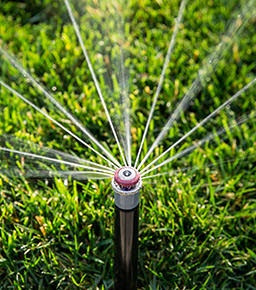
Free event will show how to upgrade irrigation, get greener grass with less cas

|
|
Give your sprinkler system a tune-up with help from
a free hands-on workshop. (Photo courtesy Regional
Water Authority)
|
Are your sprinklers ready for an upgrade?
Learn all about irrigation and how to get the most out of your sprinklers during “Sprinkler Spruce Up,” a free event hosted by the Sacramento Suburban Water District.
This hands-on workshop will be held from 11:30 a.m. to 1 p.m. Friday, April 22, at the Garden on Eden, 4900 Eden Ct. in Carmichael.
Irrigation experts will show you how to get your sprinklers ready for the summer months ahead. No registration is necessary.
Now is an excellent time to get your irrigation in good working order, before the heat of summer really hits. Outdoor landscaping accounts for more than half of Sacramento’s summer water use. With another season of drought restrictions looming, upgrading sprinkler heads can be a quick fix that adds up to big savings.
Replacing inefficient spray heads with new rotator nozzles gives the lawn much better irrigation coverage while saving an estimated 30% of water usage. The result: Greener grass while saving cash.
Questions? Contact Water Conservation Supervisor Greg Bundesen at 916-679-2890.
For more water-saving tips as well as rebates, visit BeWaterSmart.info .
Comments
0 comments have been posted.Sacramento Digs Gardening to your inbox.
Sites We Like
Garden Checklist for week of July 21
Your garden needs you!
* Keep your vegetable garden watered, mulched and weeded. Water before 8 a.m. to reduce the chance of fungal infection and to conserve moisture.
* Feed vegetable plants bone meal, rock phosphate or other fertilizers high in phosphate to stimulate more blooms and fruiting. (But wait until daily high temperatures drop out of the 100s.)
* Don’t let tomatoes wilt or dry out completely. Give tomatoes a deep watering two to three times a week.
* Harvest vegetables promptly to encourage plants to produce more. Squash especially tends to grow rapidly in hot weather. Keep an eye on zucchini.
* Pinch back chrysanthemums for bushy plants and more flowers in September.
* Remove spent flowers from roses, daylilies and other bloomers as they finish flowering.
* Pinch off blooms from basil so the plant will grow more leaves.
* Cut back lavender after flowering to promote a second bloom.
* It's not too late to add a splash of color. Plant petunias, snapdragons, zinnias and marigolds.
* From seed, plant corn, pumpkins, radishes, winter squash and sunflowers.